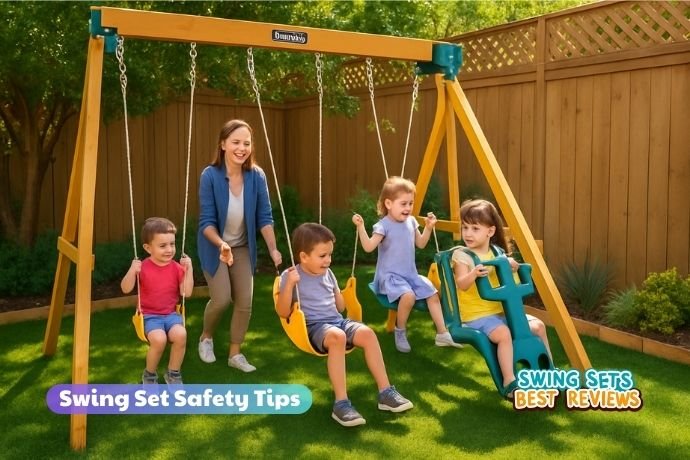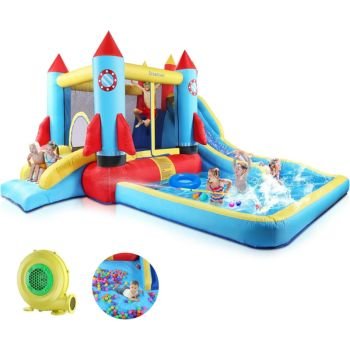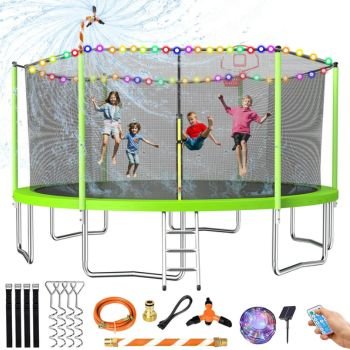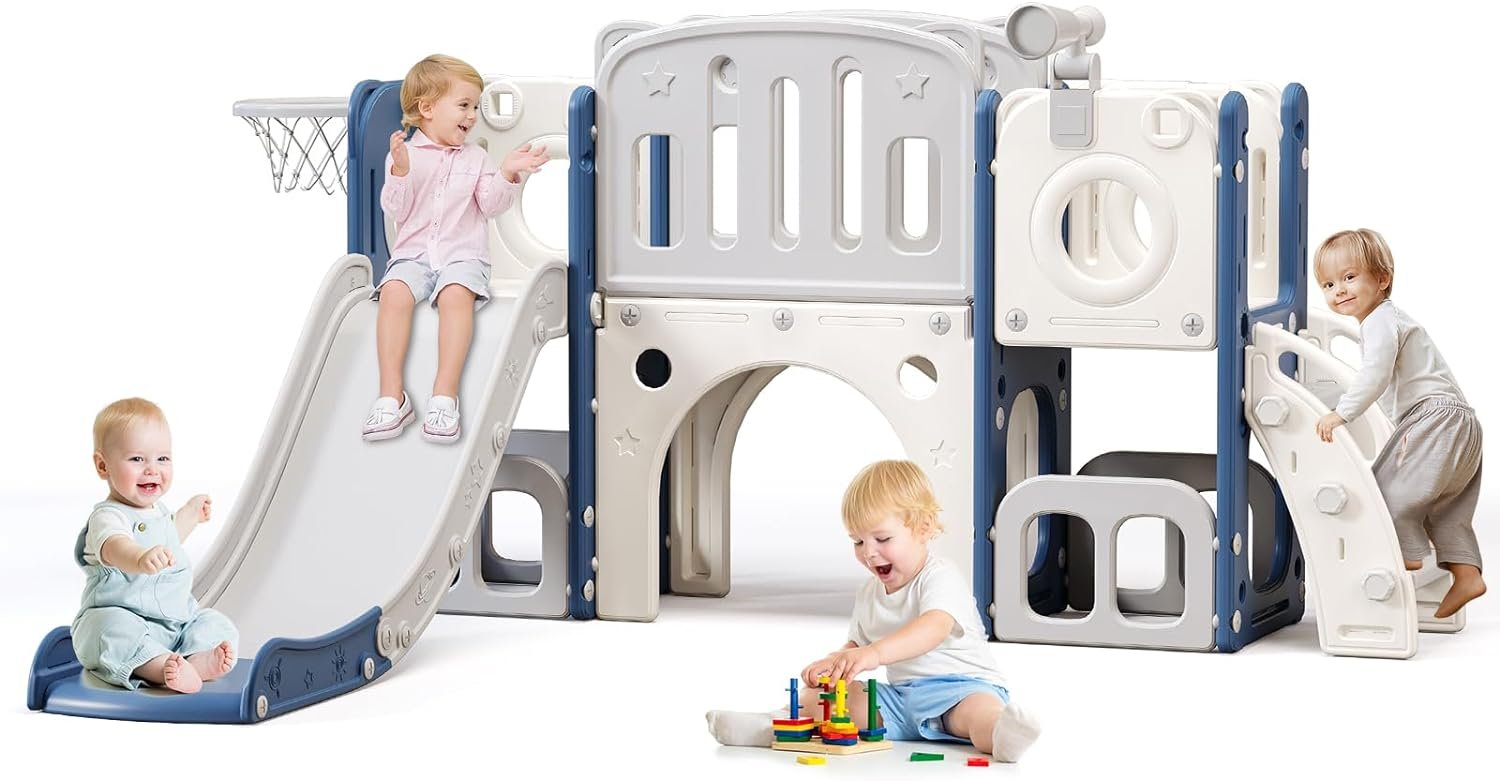Introduction to Swing Set Safety
Why Swing Set Safety Matters for Every Parent
Swing sets are often the centerpiece of childhood memories, where kids laugh, swing high into the air, and spend hours outdoors. But behind those moments of fun, there’s a hidden responsibility for parents—ensuring safety. Each year, thousands of children end up in emergency rooms because of playground accidents, and many of those involve swing sets. The truth is, while swing sets look harmless, they can pose risks like falls, entrapments, or collisions if not used correctly or if the equipment isn’t well-maintained.
For parents, knowing the right swing set safety tips can make all the difference between carefree play and a trip to the hospital. Think of it this way: a swing set is like a bicycle—it’s safe when rules are followed, but dangerous if kids are left unsupervised or if the equipment is faulty. By prioritizing swing set safety, parents not only protect their children but also build an environment where fun and security go hand in hand.
Common Risks Associated with Swing Sets
Understanding potential hazards is the first step to prevention. Some of the most common risks include:
- Falls from swings, ladders, or monkey bars – often due to lack of soft ground covering or improper supervision.
- Pinch points and sharp edges – where little fingers can easily get caught.
- Collisions – especially when kids run in front of or behind moving swings.
- Structural issues – loose bolts, rust, or unstable anchoring that compromise the set’s integrity.
By recognizing these dangers early, parents can take preventive action, making playtime safer and more enjoyable.
Choosing the Right Swing Set
Material Considerations: Wood vs. Metal vs. Plastic
When shopping for a swing set, one of the first decisions parents face is material choice. Wooden swing sets are popular for their sturdy design and natural look. However, they require regular maintenance to avoid splinters, rot, or insect damage. Metal swing sets, on the other hand, are strong and durable but can rust over time, especially if not coated properly. They also get hot in the sun, which can burn little hands. Plastic sets are usually designed for toddlers, lightweight, and resistant to weather—but they may not be as long-lasting for older children.
Each material comes with its pros and cons, so the best choice depends on your child’s age, climate, and the time you’re willing to invest in upkeep. Parents should balance safety with durability and aesthetics before making a purchase.
Age-Appropriate Swing Sets
Not all swing sets are designed for all ages. Toddlers need smaller, low-to-the-ground sets with bucket seats to prevent falling. As kids grow older, they crave more adventurous play, meaning taller swing sets with added features like slides, climbing walls, or monkey bars. Installing an age-appropriate swing set reduces the chance of injuries. One size doesn’t fit all when it comes to play equipment, so always match the swing set to your child’s developmental stage.
Safety Certifications and Standards Parents Should Check
Before buying, parents should look for certifications that indicate the swing set meets national safety standards. For example, the ASTM (American Society for Testing and Materials) and CPSC (Consumer Product Safety Commission) provide guidelines to ensure equipment is safe for children. Checking for these certifications helps parents avoid poorly made or unsafe products, ensuring peace of mind that the swing set is designed with children’s safety as a priority.
Essential Swing Set Safety Features
Importance of Secure Anchoring
A swing set without proper anchoring is like a chair with one leg shorter than the others—unstable and risky. Anchoring prevents tipping, sliding, or collapsing during play. Depending on the set, anchors may be installed with stakes, concrete, or heavy-duty bolts. Parents should ensure the swing set is level and firmly secured to the ground, especially if kids are using it daily.
Safe Swing Seat Options
Not all swing seats are created equal. Hard plastic or wooden seats may look sturdy but can cause painful bumps if they swing back unexpectedly. Soft rubber or flexible seats are generally safer because they absorb impact and reduce injury risk. For toddlers, bucket-style seats with restraints are ideal, preventing them from slipping out. Parents should avoid rope or chain-only swings, as they can pinch hands or cause rope burns.
Guardrails, Handholds, and Enclosures for Safety
Kids love to climb, but climbing can quickly turn dangerous without safety barriers. Guardrails and enclosures on elevated platforms reduce the chance of falls, while handholds help children maintain balance. Features like these are essential in preventing serious injuries, especially when kids are still developing their motor skills. When evaluating swing sets, parents should look for these built-in safety reinforcements.
Safe Installation of Swing Sets
Ideal Placement in Your Backyard
The location of a swing set plays a huge role in safety. Ideally, the set should be installed on level ground, away from fences, walls, and hard surfaces like concrete. Experts recommend at least six feet of clearance around the swing set for safe play. Placing it under a tree may seem appealing for shade, but falling branches could become hazards. A well-chosen location reduces risks and ensures a safer play zone.
Ground Surfacing Options: Mulch, Rubber, or Sand
The surface under and around the swing set is just as important as the set itself. Hard ground or grass doesn’t provide enough cushioning for falls. Instead, parents should opt for impact-absorbing materials such as rubber mulch, wood chips, or sand. These surfaces can reduce the severity of injuries from falls and meet recommended safety standards. Installing a thick enough layer—at least 9 to 12 inches—provides maximum protection.
DIY Installation vs. Professional Help
Many parents are tempted to install swing sets themselves, especially with DIY kits available. While this can save money, improper installation can compromise safety. Professional installers know how to secure anchors, align equipment, and meet safety standards. If parents choose DIY, they must carefully follow manufacturer instructions, double-check bolts, and test stability before letting kids play. Safety should always come before savings when it comes to installation.
✅ Related Articles
- The Truth About Swing and Slide Combo Playsets | Pros, Cons
- 10 Best Heavy-Duty Swing Sets for Older Kids | Tested
- 2026’s Best Swing Sets for Kids | Top 10 Picks Parents Love
- 10 Must-Have Playsets for Kids | Perfect for Small Backyards
Regular Maintenance and Inspection
Checking for Wear and Tear
Swing sets aren’t a one-time investment—they require ongoing care. Parents should regularly inspect for cracks, splinters, rust, or loose screws that may weaken the structure. A quick 10-minute check every week can prevent accidents that could have been avoided.
Preventing Rust, Splinters, and Loose Bolts
Wooden sets should be sanded to prevent splinters and treated with sealants to protect against rot. Metal sets need anti-rust coatings, while bolts and chains should be tightened regularly. By staying on top of maintenance, parents extend the life of the swing set and ensure it stays safe year after year.
Seasonal Maintenance Checklist
Every season brings new challenges. Winter may cause wood to crack, while summer heat can warp plastic. A seasonal maintenance checklist helps parents stay proactive. This includes inspecting all moving parts, reapplying protective coatings, and refreshing ground surfacing if it has compacted or thinned out. Regular seasonal care ensures swing set safety year-round.
Teaching Kids Swing Set Safety Rules
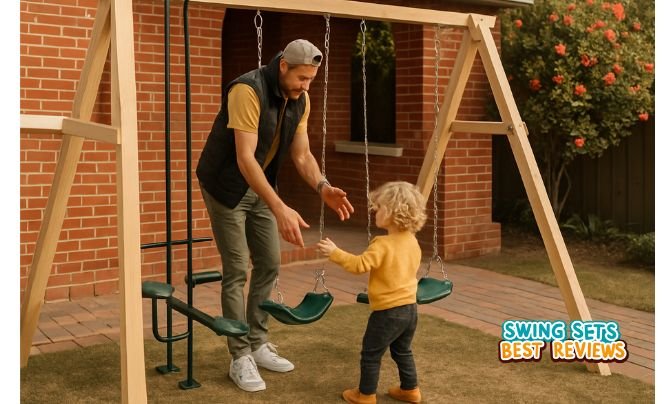
Supervision and Playtime Boundaries
Even with the safest swing set and perfect installation, children need guidance on how to play responsibly. One of the best swing set safety tips is establishing clear boundaries. Kids should know where they can and cannot go while others are swinging. For example, standing too close to the path of a moving swing can lead to painful collisions. Parents should also set time limits to avoid fatigue, as tired kids are more likely to make mistakes.
Supervision plays a huge role here. Active supervision means being close enough to intervene if a child is about to misuse the swing set. Passive supervision—like watching from a distance—works for older kids but may not be safe for toddlers. By combining supervision with established rules, parents create a balance between freedom and safety.
Teaching Proper Use of Swings and Slides
Children are naturally curious, which sometimes means they’ll try to climb up slides or twist chains on swings. While these seem like harmless acts, they can lead to dangerous situations. Parents should teach kids to always sit properly on swings, hold on with both hands, and never jump off while in motion. Slides should only be used one at a time, with kids going down feet-first to prevent head injuries.
A fun way to reinforce rules is through play. Parents can role-play “safe vs. unsafe” behaviors, turning lessons into games. Over time, children develop habits that make safe play second nature.
How to Handle Rough Play or Crowding
Playgrounds can quickly get crowded, especially during family gatherings or neighborhood playdates. Crowding often leads to pushing, rushing, or rough play that increases the risk of accidents. Parents should establish a “one child at a time” rule for swings and slides. If multiple kids want a turn, create a fair system—like counting swings or using a timer.
Teaching respect and patience not only prevents injuries but also helps kids develop social skills. Parents who address rough play immediately send a clear message: safety always comes first.
Preventing Common Swing Set Injuries
Falls: The Leading Cause of Accidents
Falls are the number one cause of swing set injuries. Whether it’s slipping off a swing, losing grip on monkey bars, or tumbling from a slide, falls are inevitable—but their severity can be reduced. One key swing set safety tip is to ensure proper ground surfacing, such as rubber mulch or sand, which cushions impacts.
Parents should also remind kids to use both hands when climbing and avoid jumping from high points. Younger children, especially toddlers, should never be left alone on elevated platforms. By combining safe design with active supervision, parents can drastically lower fall-related injuries.
Pinch Points and Sharp Edges
Small fingers are at high risk of getting pinched between chains, hinges, or moving parts. To prevent this, parents should look for swing sets designed with safety in mind—such as coated chains, capped bolts, and smooth edges. Any exposed hardware should be covered, and routine inspections can catch potential hazards before accidents happen.
Sharp edges, especially on older or poorly maintained swing sets, should be sanded down or replaced immediately. These small preventive steps can make a big difference in protecting kids.
Avoiding Collisions Between Kids
One of the most overlooked risks is collisions—children running too close to moving swings or crowding slides. To prevent this, parents should enforce a “safe zone” around swings. A good rule of thumb is to keep kids at least three feet away from any moving swing.
Encouraging kids to wait their turn and respect playtime rules reduces the risk of collisions. Parents can even use visual markers like cones or painted lines to remind kids where the safe zones are.
Weather-Related Swing Set Safety Tips
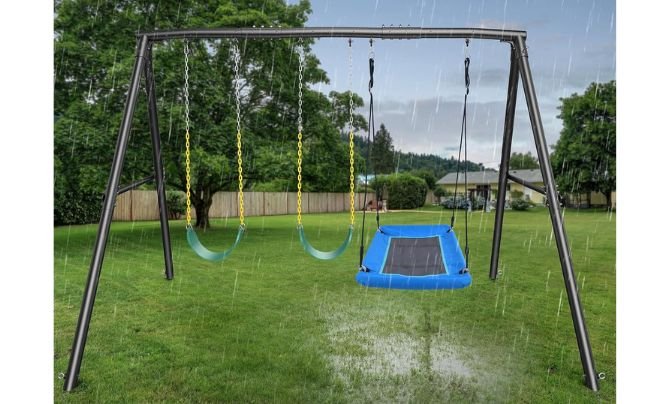
Playing Safely in Hot Weather
On a sunny day, swing sets can become surprisingly dangerous. Metal seats, chains, and slides can heat up to the point of causing burns. Before allowing children to play, parents should always check the temperature of surfaces. If they’re too hot, cover them with a towel or wait until the area cools.
Hydration is another key factor. Kids often get caught up in play and forget to drink water, increasing the risk of heat exhaustion. Parents should schedule breaks, provide shaded areas, and encourage water breaks every 20–30 minutes.
Cold Weather Hazards
In cold climates, swing sets can become brittle and slippery. Metal parts may contract and weaken, while icy surfaces increase the risk of falls. Parents should regularly check equipment for cracks or frozen parts before letting kids play. Gloves, hats, and non-slip footwear can make outdoor play safer during colder months.
While kids may love playing in the snow, parents should remind them to use swings and slides with extra caution. Snow piles can hide hazards, and slippery conditions require more supervision.
Storm and Rain Safety Precautions
Rain creates slippery surfaces that increase the risk of falls. After a rainstorm, parents should dry off seats and platforms before allowing kids to play. Strong winds or storms pose even greater risks, as falling branches or unstable equipment can cause serious injuries.
One of the best swing set safety tips is to establish a clear rule: no outdoor play during storms. Teaching kids about weather safety ensures they understand why these precautions matter, even when they’re eager to play.
Swing Set Safety for Toddlers vs. Older Kids
Special Considerations for Toddlers
Toddlers are at the highest risk of swing set injuries because they are still developing balance and coordination. For them, parents should choose bucket-style swings with safety harnesses. These swings prevent kids from sliding out and offer more stability.
Climbing structures and tall slides should be avoided until toddlers are older and more capable. Parents should also stay within arm’s reach during play. At this age, swing set safety isn’t just about equipment—it’s about constant supervision and gentle guidance.
Safety Rules for School-Aged Kids
As kids grow, they crave independence and more adventurous play. School-aged children can handle higher swings and taller slides, but that doesn’t mean safety rules should be relaxed. Parents should remind them to respect turn-taking, avoid jumping from high platforms, and use equipment as intended.
Peer pressure can sometimes encourage risky behavior, like standing on swings or climbing where they shouldn’t. Parents should talk openly about these risks, explaining how one small mistake can lead to injury.
When Kids Outgrow Their Swing Set
There comes a time when children outgrow their swing sets, making them more of a hazard than a fun activity. Older kids may be too heavy for certain equipment, causing instability or breakage. Parents should monitor weight and height limits provided by manufacturers.
When kids show less interest or start misusing the equipment, it may be time to upgrade to a more age-appropriate set—or encourage other outdoor activities. Recognizing when a swing set has served its purpose is part of long-term swing set safety.
Creating a Safe Play Environment
Keeping the Play Area Clean and Obstacle-Free
A safe swing set is only as good as the environment it’s in. Parents should regularly check the play area for hazards like rocks, broken toys, or garden tools that could cause trips and falls. Debris such as fallen branches or sharp objects should be cleared away before playtime begins.
A clean play area also helps kids focus on play without distractions or hidden dangers. Parents can make it a fun routine by involving children in “safety checks” before they start playing.
Fencing and Boundaries Around Swing Sets
Installing a fence around the play area serves multiple purposes. It keeps pets and wildlife away, prevents balls or toys from rolling into unsafe areas, and clearly defines play boundaries for children. For families living near busy streets, fencing adds an essential layer of security.
Boundaries don’t always need to be fences—landscaping, low hedges, or even play mats can help establish limits while still keeping the area welcoming.
Adding Shade for Comfort and Protection
Shade is often overlooked, but it’s vital for both safety and comfort. Direct sun exposure not only overheats equipment but also increases the risk of sunburns and dehydration. Parents can add shade through canopies, pergolas, or strategically planted trees.
Shaded play areas make outdoor time more enjoyable, allowing kids to play longer without overheating. A small investment in shade structures can significantly improve the overall swing set safety environment.
Emergency Preparedness and First Aid
First Aid Kit Essentials for Outdoor Play
No matter how careful parents are, accidents can still happen. That’s why having a well-stocked first aid kit near the play area is one of the most important swing set safety tips. A kit should include basics like adhesive bandages, antiseptic wipes, gauze pads, tweezers, and adhesive tape. For outdoor play, it’s also smart to pack insect bite cream, sunscreen, and an ice pack for bumps and bruises.
Parents should store the kit in a waterproof container and keep it within easy reach. Teaching older kids how to use basic first aid items can also be empowering. While the kit won’t replace professional medical help, it ensures that minor injuries are treated quickly and effectively.
Handling Cuts, Bruises, and Minor Injuries
Scrapes and bruises are part of childhood, but knowing how to treat them properly prevents small issues from becoming bigger ones. Cuts should be cleaned with antiseptic wipes, covered with a sterile bandage, and checked regularly for signs of infection. Bruises respond best to ice packs, which help reduce swelling and discomfort.
Parents should also encourage children to communicate when they’re hurt. Sometimes kids try to hide pain to keep playing, which can make injuries worse. Responding calmly and reassuringly teaches children that safety always comes before play.
When to Seek Professional Medical Help
While most playground injuries are minor, some require immediate professional attention. Parents should seek medical help if:
- The child experiences severe pain, swelling, or difficulty moving a limb.
- There’s heavy bleeding that doesn’t stop after applying pressure.
- A head injury leads to dizziness, vomiting, or loss of consciousness.
- A suspected fracture or dislocation occurs.
Knowing the difference between minor injuries and emergencies allows parents to respond appropriately, ensuring their child’s safety and health.
The Role of Parental Supervision
Active vs. Passive Supervision
Supervision comes in different forms, and understanding the difference is key to swing set safety. Active supervision means staying close, engaging with the child, and being ready to intervene at a moment’s notice. This approach is best for toddlers and younger children. Passive supervision, on the other hand, involves watching from a distance—like sitting on the porch while kids play. This method may be acceptable for older children but only when clear rules are already in place.
Active supervision might seem demanding, but it significantly reduces risks. Even a few seconds of distraction can lead to accidents, which is why parents are encouraged to stay present and attentive.
Setting Rules and Consequences
Children thrive when they understand boundaries. Parents should set simple, clear swing set rules like:
- Always sit on swings, never stand.
- Wait for your turn before using the slide.
- Keep hands and feet to yourself.
- No rough play or pushing.
Enforcing these rules consistently with age-appropriate consequences helps children take safety seriously. Rather than punishing harshly, parents can use natural consequences—such as losing playtime privileges—to reinforce lessons.
Encouraging Independent but Safe Play
As kids grow, they want more freedom. Parents can encourage independence while still prioritizing safety by teaching problem-solving skills. For example, instead of stepping in immediately when two kids argue over turns, parents can guide them to resolve it fairly.
By gradually giving children more responsibility, parents help them develop awareness and self-control. This balance of independence and supervision allows kids to enjoy their playtime while staying safe.
👉 You Might Be Interested In
- Best Outdoor Climbing Toys for Kids Under 5
- 10 Best Budget Swing Sets Under $500 That Parents Love
- Premium Wooden Swing Sets | The Ultimate Backyard Upgrade in 2026
- 10 Must-Have Playsets for Kids | Perfect for Small Backyards & Limited Spaces
- 10 Best Toddler Swing Sets for Indoor & Outdoor Fun
Swing Set Safety in Public Playgrounds
Differences Between Home and Public Swing Sets
Public playground swing sets often come with more features and taller equipment compared to home versions. While this can be exciting for children, it also introduces new risks. Unlike backyard swing sets, public ones are used by dozens of kids daily, which means more wear and tear.
Parents should explain the differences to children before visiting public playgrounds. Kids need to understand that rules still apply—even if the equipment looks bigger or more tempting.
Inspecting Public Playgrounds Before Play
Before letting kids loose, parents should take a few minutes to check the equipment. Look for broken chains, missing bolts, or sharp edges. Surfaces should be inspected too—sometimes public areas lack proper cushioning, increasing the risk of injury from falls.
If something looks unsafe, parents should redirect children to safer sections of the playground or report the issue to local authorities. Quick inspections show kids that safety always comes before fun.
Teaching Kids to Respect Shared Play Spaces
Public playgrounds teach children more than just physical skills—they also offer lessons in sharing and cooperation. Kids should be taught to wait patiently for swings, avoid cutting in line, and respect other children’s play. Parents can model this behavior by encouraging polite interactions and praising kids when they follow playground etiquette.
Respecting shared play spaces not only makes the playground safer but also helps children develop social responsibility.
Upgrading and Replacing Swing Sets
Knowing When It’s Time for an Upgrade
No swing set lasts forever. Over time, even well-maintained sets show signs of wear, making them unsafe. Parents should consider an upgrade if they notice excessive rust, rotting wood, or weakened joints that compromise structural stability.
Another sign is when the swing set no longer matches the child’s age or weight. A toddler’s bucket swing may not work for a 7-year-old, and older kids may try to misuse equipment that’s too small for them. Recognizing these signs early prevents unnecessary accidents.
Donating or Recycling Old Swing Sets
If the swing set is still safe but too small, families can donate it to neighbors, schools, or community centers. Recycling is another option—metal and wood components can often be repurposed. Responsible disposal prevents unsafe equipment from ending up in someone else’s backyard.
Donating not only clears space for a new set but also gives other children the chance to enjoy safe outdoor play.
Choosing Modern Safety-Enhanced Models
Modern swing sets come with improved safety features like coated chains, non-slip steps, and durable weather-resistant materials. Some even include built-in shade covers and modular designs that grow with the child.
When choosing a replacement, parents should prioritize swing sets that meet safety certifications. Investing in a model designed with long-term safety in mind ensures peace of mind for years to come.
Conclusion
Final Thoughts on Swing Set Safety Tips
Swing sets bring joy, exercise, and laughter to children, but safety must always come first. By following these swing set safety tips—from installation and maintenance to supervision and emergency preparedness—parents can create a play environment that’s both fun and secure. Safety doesn’t mean restricting play; it means making sure every moment is worry-free.
Encouraging Safe Play for Lifelong Fun
When children learn to play safely, they develop lifelong habits of responsibility and awareness. Parents who actively teach and reinforce swing set safety are giving their kids more than just a safe childhood—they’re building the foundation for safe independence in all aspects of life.
Outdoor play should be a source of joy, not stress. With the right swing set safety strategies, families can enjoy countless hours of carefree fun together.
FAQs
1. What age is safe for kids to start using a swing set?
Most children can safely use a toddler swing around 6 months old with proper support. However, free-swinging seats are best for children 2 years and older.
2. How often should I inspect my child’s swing set?
A quick weekly inspection is ideal, with a more thorough seasonal check to ensure all parts are secure and safe.
3. Are metal or wooden swing sets safer?
Both can be safe if properly maintained. Wooden sets need protection from rot, while metal sets require rust prevention.
4. What ground covering is best for swing set safety?
Rubber mulch, wood chips, or sand are the best options for cushioning falls. Grass or concrete should be avoided.
5. Do I need professional installation for a swing set?
Not always, but professional installation ensures stability and compliance with safety standards. DIY is fine if done carefully.



